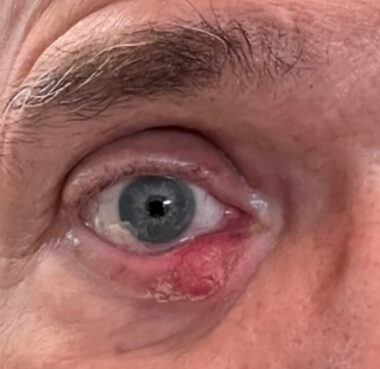With Fabry disease, I didn’t expect this many eye health problems
A columnist describes the slew of eye issues he's had in recent years
Written by |

The manifestations of my Fabry disease are much improved and now stable after more than 21 years of enzyme replacement therapy, as well as a heart transplant I had in late 2020. But Fabry continues to occasionally surprise me. In the past few years, for example, I’ve experienced unexpected eye issues.
I was never too concerned about my eyes because medical literature about Fabry indicates that ocular findings typically don’t cause significant visual impairment. However, my experiences have shown that complications related to vision and atypical eye manifestations do occur.

An example of blood vessel occlusion and rupture in columnist Jerry Walter’s eye. (Courtesy of Jerry Walter)
The ocular manifestations I’ve experienced are:
- cornea verticillata, an opaque, whorl-like pattern in the eyes
- retinal vessel tortuosity (twisted blood vessels) and occlusions
- cataracts
- chronic chemosis (a fluid-filled, blister-like bump on the surface of the eye)
- dry eye syndrome.
From 1979, when I learned I had Fabry disease, to 2009, I experienced no eye problems. Except for getting reading glasses in 1994, when I was 40, I had great vision and didn’t require an eye doctor.
In 2009, I had a sudden eye problem that was diagnosed as chemosis. It initially caused significant pain and irritation in my eye and eyelid, but it cleared up in a couple of months. When I opened and closed my eyelid and brushed the bump of fluid, it felt like something was stuck in my eye. After the first time, the fluid accumulation and swelling returned periodically until one day, a couple of years ago, it happened and the fluid buildup remained.
Multiple conditions
The chronic chemosis now is not as severe as the first time, but the amount of fluid changes often, which affects the amount of eye irritation I experience. My eyes water frequently from the irritation. I have an appointment with an ophthalmic plastic surgeon in June to attempt to remove the fluid accumulation and repair my eye so that it won’t return. If the surgery is successful, I’ll be happy to not feel like I have something in my eye every day.
Next, in 2015, I experienced the symptoms of retinal detachment in my right eye. I was alarmed at the gray, curtain-like covering that developed over my eye, the frequent flashes of bright light, and the black floaters traversing my eye.
Then, I lost my vision and worried I wouldn’t ever regain it, which, thankfully, didn’t happen, as I could see again a couple of days later. After a visit with an eye doctor, my diagnosis was amaurosis fugax, which can mimic retinal detachment symptoms. Eventually, all the symptoms subsided.
Despite the premise that Fabry eye manifestations usually do not affect vision, from about 2021 until mid-2023, my vision progressively worsened, especially at night. In June 2023, I requested a referral to a cataract surgeon and soon underwent successful cataract surgery. My distance vision returned to 20/20, but I still need reading glasses.
My most recent annoying eye manifestation is having multiple styes with crusty buildup on the lower and upper eyelids of both eyes since last December. They won’t completely resolve. This was diagnosed as blepharitis.
I didn’t have a history of styes until now. The first stye on my right eyelid fought two rounds of antibiotics and many warm compresses. After the right stye finally got better (temporarily), I developed a stye on my left eyelid. They seem to improve and then return, and new styes form. I’ve had six styes since December.

A stye that appeared on the columnist’s right eye. (Courtesy of Jerry Walter)
I hope to wake up one morning without seeing or feeling the styes anymore, as they’ve been stubborn and difficult to manage. I’ve found that putting warm compresses and antibiotic cream on my eyelids is helpful.
I’ve experienced several episodes of central retinal vein occlusion and ruptures thought to be caused by Fabry lipid accumulation. The occlusions haven’t been painful and usually clear up in two or three weeks. They aren’t troublesome but make good conversation starters.
All of these unexpected eye problems may not be directly related to Fabry disease, but my suspicions are high.
I’ve learned to frequently use lubricant eye drops to ease my eye irritation. I buy the preservative-free versions to minimize the risk of other complications.
Nowadays, I take more time every day to keep my eyes clean and healthy to preserve my vision and minimize irritation. I’ve learned that establishing a good eye-care routine is important.
Note: Fabry Disease News is strictly a news and information website about the disease. It does not provide medical advice, diagnosis, or treatment. This content is not intended to be a substitute for professional medical advice, diagnosis, or treatment. Always seek the advice of your physician or other qualified health provider with any questions you may have regarding a medical condition. Never disregard professional medical advice or delay in seeking it because of something you have read on this website. The opinions expressed in this column are not those of Fabry Disease News or its parent company, Bionews, and are intended to spark discussion about issues pertaining to Fabry disease.







Lynn Boudreau
Great info. Jerry. Appreciate it and you. I have experienced some of what you describe and faithfully see my eye Dr. 1-2 times a year. Wishing you better eye health . Lynn